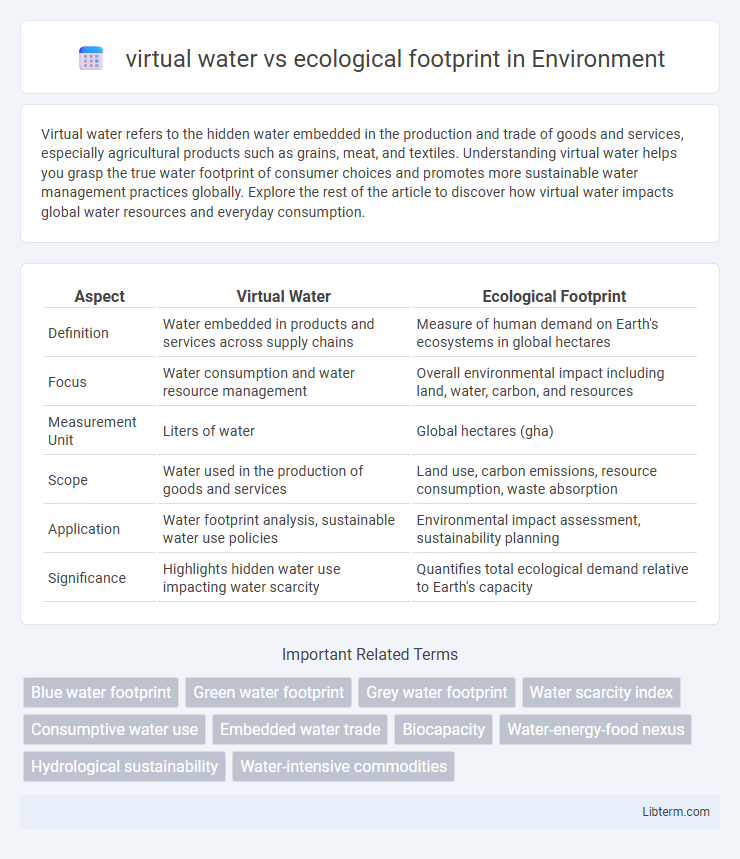Virtual water refers to the hidden water embedded in the production and trade of goods and services, especially agricultural products such as grains, meat, and textiles. Understanding virtual water helps you grasp the true water footprint of consumer choices and promotes more sustainable water management practices globally. Explore the rest of the article to discover how virtual water impacts global water resources and everyday consumption.
Table of Comparison
| Aspect | Virtual Water | Ecological Footprint |
|---|---|---|
| Definition | Water embedded in products and services across supply chains | Measure of human demand on Earth's ecosystems in global hectares |
| Focus | Water consumption and water resource management | Overall environmental impact including land, water, carbon, and resources |
| Measurement Unit | Liters of water | Global hectares (gha) |
| Scope | Water used in the production of goods and services | Land use, carbon emissions, resource consumption, waste absorption |
| Application | Water footprint analysis, sustainable water use policies | Environmental impact assessment, sustainability planning |
| Significance | Highlights hidden water use impacting water scarcity | Quantifies total ecological demand relative to Earth's capacity |
Introduction to Virtual Water and Ecological Footprint
Virtual water represents the total volume of freshwater used to produce goods and services consumed by individuals or communities, highlighting hidden water consumption embedded in trade and daily activities. The ecological footprint measures the biologically productive land and water area required to generate the resources a population consumes and to absorb its waste, serving as a comprehensive indicator of human demand on Earth's ecosystems. Comparing virtual water and ecological footprint provides critical insights into water usage efficiency and environmental sustainability within global resource management.
Defining Virtual Water: Concept and Importance
Virtual water refers to the hidden volume of freshwater used to produce goods and services, encompassing the water consumed throughout the entire supply chain. This concept is crucial for understanding the true water footprint associated with consumption, especially in agriculture and manufacturing sectors. Measuring virtual water helps identify water-intensive products and informs sustainable resource management to reduce ecological footprints globally.
Understanding the Ecological Footprint Metric
The ecological footprint metric quantifies the demand human activities place on Earth's ecosystems by measuring the biologically productive land and water area required to produce consumed resources and absorb waste. Virtual water, the hidden water embedded in goods and services, directly influences the ecological footprint by reflecting water resource consumption linked to production and trade. Understanding this connection enhances accurate assessments of resource use and sustainability, helping policymakers address water scarcity and environmental impact more effectively.
Key Differences Between Virtual Water and Ecological Footprint
Virtual water measures the total volume of freshwater used to produce goods and services, emphasizing water consumption embedded in products. The ecological footprint quantifies the biologically productive land and water area required to sustain a population's resource demands and absorb wastes, reflecting overall environmental impact. Key differences lie in scope: virtual water focuses solely on water use, while ecological footprint encompasses a broader range of resource consumption and environmental pressures.
How Virtual Water Impacts Global Water Resources
Virtual water consumption significantly influences global water resources by embedding hidden water usage in the production and trade of goods, particularly agricultural products. This indirect water use exacerbates pressure on freshwater supplies in water-scarce regions, often leading to unsustainable withdrawals from aquifers and rivers. Managing virtual water flows offers a strategic approach to reducing ecological footprints and promoting efficient allocation of global water resources.
Ecological Footprint: Assessing Environmental Sustainability
Ecological Footprint measures the demand humans place on Earth's ecosystems by quantifying the land and water area required to produce the resources consumed and absorb waste generated. Unlike virtual water, which tracks the water embedded in goods and services, the Ecological Footprint offers a comprehensive assessment of environmental sustainability by encompassing carbon emissions, cropland, grazing land, fishing grounds, and built-up land. This metric helps identify whether human activities exceed the planet's biocapacity, guiding policies toward sustainable resource management and ecological balance.
Virtual Water in Food and Consumer Products
Virtual water quantifies the total volume of freshwater embedded in the production and supply chain of food and consumer products, reflecting water consumption beyond direct use. In agriculture, livestock, and manufacturing sectors, virtual water content varies significantly, influencing global water resource distribution and trade patterns. Analyzing virtual water alongside ecological footprints reveals hidden water dependencies integral to sustainable consumption and international resource management.
Integrating Virtual Water and Ecological Footprint in Policy Making
Integrating virtual water and ecological footprint metrics in policy making enhances resource management by highlighting water-intensive supply chains and their overall environmental impacts. Policymakers can develop targeted strategies to reduce water consumption and carbon emissions by considering both embedded water in products and the total ecological footprint of regions. This holistic approach supports sustainable development goals by promoting water-efficient production and lower environmental degradation.
Case Studies: Comparative Analysis of Both Metrics
Case studies comparing virtual water and ecological footprint metrics reveal distinct insights into resource consumption and environmental impact. In agricultural regions, virtual water analysis highlights water input embedded in crop production, while ecological footprint assessments capture overall land and carbon demands. Integrating both metrics in case studies offers a comprehensive evaluation of sustainability, guiding resource-efficient policy decisions.
Future Perspectives and the Role in Sustainable Development
Virtual water accounting offers critical insights for reducing global water scarcity by optimizing water use in agriculture and trade, directly influencing ecological footprints. Integrating virtual water metrics with ecological footprint analyses enables policymakers to develop targeted strategies for sustainable resource management and reduce environmental degradation. Future perspectives emphasize leveraging virtual water data to balance consumption patterns with ecosystem capacities, crucial for achieving Sustainable Development Goals related to water security and environmental sustainability.
virtual water Infographic

 libterm.com
libterm.com